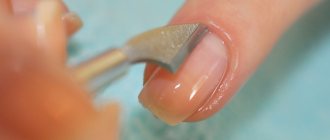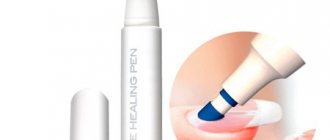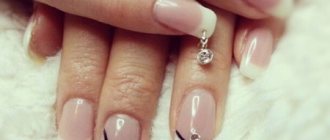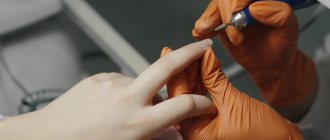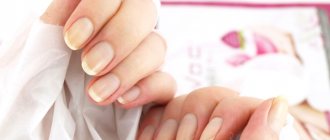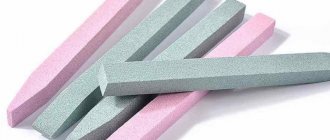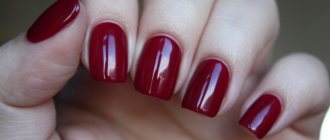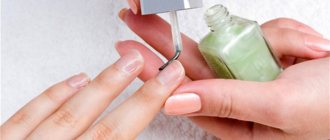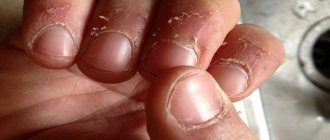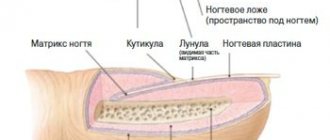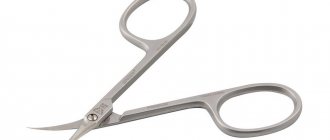Do you dream of beautiful and healthy nails?
A hardware manicure will help keep your hands in perfect condition - simple, effective and safe. Today, this is the most progressive method of treating the nail plate and adjacent areas, which almost eliminates the possibility of injury. Manipulations are carried out using a special device - a milling cutter with several interchangeable attachments. It allows you to quickly and easily: get rid of the old decorative coating, give the desired shape to the edge of the nail plate, remove the cuticle, pterygium and deeply clean the lateral sinuses, sand the nail and, if necessary, level its surface before applying a new layer of varnish.
Which is better – edged or hardware manicure:
We are constantly looking for the most gentle ways to get our hands in order. The aggressive trimmed manicure was replaced by the European one, with its careful processing of the cuticle without removing it. However, this technology is not suitable for everyone.
Hardware manicure is the next step towards the development of the nail industry. Its undoubted advantages:
- The cutter carefully removes only dead skin particles without damaging the cuticle, as often happens when trimming with tweezers. As a result, there is no danger of wounds with further possibility of infection. Not only thin, but also denser cuticles are effectively removed, leaving the nail hole smooth and neat.
- To perform a classic manicure with high quality, hands are first steamed in a bath, which provokes the spread of fungal diseases. Hardware treatment is performed on dry skin, so it is much more hygienic.
- After gentle removal with a cutter, the cuticle grows longer and does not become rough, as with a trimmed manicure.
- Problematic nails are treated delicately: brittle, flaking, uneven, damaged by improper extensions. As a result, any gel polish then fits and lasts much better on them.
- The skin around the nails looks healthier and more well-groomed. You can also use a cutter to remove calluses from your fingers if they have formed from work.
- The procedure is easy to carry out at home. It is enough to go through video training, watch relevant lessons and step-by-step photos from professionals, and then practice a little to achieve tangible success. The machine for hardware manicure is so easy to use that high-quality nail treatment will not be a problem even for beginners.
- All necessary operations are performed in 30–50 minutes. For a trimmed manicure, the master will need 1.5 hours.
Machine processing is often called the improved European method. Problems can only arise if the nails are in very poor condition. It will not be possible to bring them back to normal in one session.
Sterilization of instruments
There are 4 types of sterilization:
- thermal;
- quartz;
- chemical;
- steam
According to SanPiN, the most effective methods are considered to be treatment with high temperature and pressure and exposure to an infrared sterilizer. The modern market offers a wide selection of such equipment. It is necessary to check the registration certificate of Roszdravnadzor before purchasing.
Most often, nail service studios use a dry-heat cabinet. Cleaned and disinfected instruments in craft bags are placed in it. In the device they are exposed to high temperatures from 120 to 180⁰ C for 30 minutes. This method is ideal for sterilizing cutters.
What do you need for a hardware manicure at home?
First of all, we need a router and a set of attachments for it. In addition, you will need additional tools:
- Orange sticks or pusher to push back cuticles.
- A special brush that is used to remove dust while processing nails.
- A file (preferably glass or ceramic) with a hardness of 180 – 240 grit.
- Often craftsmen buy a special desktop vacuum cleaner for the convenience of sawdust extraction.
How to choose a router for home hardware manicure?
- The power of the device must be at least 35 W. If you plan to do manicures not only for yourself, but also for clients, the optimal value will be 100 - 120 W.
- Another important indicator is speed. For a hardware manicure at home, a cutter rotation speed of 20 thousand rpm will be sufficient, and a pedicure will require 35 - 40 thousand rpm.
- The device should not be too expensive, but you should avoid cheap models as their quality leaves much to be desired.
- A machine with reverse is preferable.
- It is important that the handle of the router has a collet clamp - it is the most convenient and reliable, and is also equipped with a cooling system.
Is it possible to learn from video?
It is not necessary to attend in-person courses to become proficient in using the device. A detailed hardware manicure master class, presented in video or photo, allows you to save time and money. Learning online is no different, the main thing is to master the theory and practice more. Beginners sometimes make mistakes that make them consider nail art incomprehensible. When following the instructions from the video, do not forget about the following mistakes:
- Neglecting tool processing. Nozzles, tweezers, and files must be disinfected to avoid problems. Firstly, the cutters will quickly become dull, and secondly, an infection can occur.
- Speed. When doing a hardware manicure for yourself, you should never forget about safety. During training, it is better to reduce the speed to avoid injury.
- Choice of cutters. Surely everyone has noticed how professionals deftly wield the “Bullet” or “Flame” attachments. A novice master can easily make too deep a cut in the nail, so it’s better to forget about these cutters for a while.
- Work with apparatus and cutters. We must remember that the attachments heat up, as does the device. Movements should be smooth, but you cannot linger in one place. In addition, it is recommended to take breaks every 5-10 minutes, giving the device a rest.
- Dry hands. You cannot wet the skin or lubricate it with oil or solvents for the epidermis beforehand. The cuticle must be dry - the quality of processing depends on this.
There is a training video on hardware manicure for different skill levels. They start with basic knowledge, smoothly moving on to more complex lessons. There is no need to leave the house. Moscow or St. Petersburg, Kazan or Krasnodar - for online courses, the student’s city of residence is not important, because studying and subsequent skills development take place remotely.
It's not just the face that people pay attention to when meeting people. The condition of the hands tells a lot about a woman. Some do not trust salons and craftsmen, fearing poor quality work. After watching several video tutorials, everyone will be able to do their own manicure without worrying about the safety of their nails.
Description of cutters for hardware manicure
Diamond tips work best with thin cuticles; you can “trust” them with the most complex nails. However, the cost of such products is high. When performing hardware manicure at home, two cone-shaped diamond cutters of different diameters will be quite sufficient.
Diamond cutters
Ceramic cutters
Advice: ceramic nozzles are ideal for beginner craftswomen. They are considered the safest because they do not injure the skin and do not heat up during operation.
Pay attention to the markings of the cutters. For manicure, you usually need a tool with a red and blue line, which means low and medium abrasiveness, respectively.
Which attachments should I use for what?
| Type of cutter | Function | |
| Boron (ball) | Thins and gently removes the keratinized part of the cuticle, polishes the nail fold | |
| Flame | Treatment of the lateral sinuses | |
| Cone with rounded point | Cleaning the pterygium, making the side ridges smooth. | |
| Frustum | Sanding the skin adjacent to the nail plate | |
| Reverse cone | Forming the free edge of the nail during a French manicure | |
| Rounded cylinder | A universal tool. Lifts cuticles, cleans nails from pterygium, polishes, removes artificial coating. | |
| Needle | Deep cleaning of the lateral sinuses and sinuses | |
| Silicone polisher | Adding gloss to the nail plate and surrounding skin |
Contraindications to the procedure
It is not permissible to perform a hardware manicure on the nails of a woman suffering from one of the following ailments:
- The cuticles are inflamed and swollen;
- The skin next to the nail has damage (scratches, wounds);
- The nail is affected by a fungal infection;
- The cuticle is too thin;
- Microvessels are located too close to the cuticle;
- Severely deformed nail plates also cannot be treated with the device.
Don't miss the most popular article in the section: How to draw monograms on nails step by step for beginners. Instructions with photos.
How to properly do a hardware manicure at home
Attention: To treat your own nails, it will be enough to read the step-by-step description of the hardware method on the Internet and watch the corresponding video materials intended for training beginners. However, if you plan to serve clients, you should complete professional courses where they will tell you about the secrets and intricacies of this procedure.
Hardware manicure for beginners step by step
Apply disinfectant solution to your hands.
We give the free edge of the nail plate the desired shape with a file with an abrasiveness of 180 grit.
Before doing a hardware manicure, carefully push back the cuticle using a pusher or a wooden stick (the second method is more delicate).
We remove the pterygium and lift the cuticle using a cone-shaped cutter with a rounded tip.
Important: The nozzle must be positioned parallel to the nail plate so as not to accidentally make a cut.
We work in reverse. When moving the cutter to the right, move your hand to the left and vice versa. Correctly performing a manicure involves first treating one side of the nail on all ten fingers and only then, after switching the cutter, the other.
At the same time, we grind the side rollers.
Manicure for beginners at this stage is optimally done at 15 - 17 thousand rpm.
We thin the cuticle with a spherical bur, d 1.2 mm.
Important: Hold the cutter perpendicular to the nail plate. We move the ball only along the skin so as not to leave scratches. It is very important, when going through the sinus, not to change the position of the cutter, following the shape of the nail, otherwise you can snag and tear the cuticle skin. We guide the nozzle all the time in one direction, turning not it, but the finger.
We cut the cuticle with a round bur, d 3.0 mm, with fine abrasiveness. Here you need to move parallel to the nail, repeating the shape of the hole. We work at 17 thousand rpm.
Important: do not hold the ball at one point for more than 5 seconds. Even if the desired result was not achieved, it is necessary to move to another area to avoid overheating of the skin.
Using a rough grinder, we process the nail plate for a decorative coating. You can replace the cutter with a buff with the same abrasiveness.
Use a gray polisher to go over the skin adjacent to the nail. The rotation speed of the cutter should be no more than 7 thousand rpm. We work only with the tip of the polisher, making light pushing movements and moving along the cuticle growth zone.
Using oil with regenerating properties, we nourish the nails and, at the same time, remove sawdust from them. Remove excess with a napkin.
The main mistakes in performing a manicure
- Careless attitude towards the router and other working tools. Poor quality, poorly cleaned of sawdust, undisinfected attachments can lead to problems with nails and skin of the hands.
- High speed. While we are just undergoing training in hardware manicure, we cannot work at high speeds, this is fraught with injuries.
- Incorrectly selected cutters when removing pterygium. “Bullet” and “flame”, loved by many beginners, do not open the cuticle enough and also leave cuts on the nail.
- Working with a polisher. Do not hold the cutter in one place for more than 1 second or bring it close to the edge of the nail.
- Incorrectly selected abrasiveness. Nozzles with blue markings are suitable for coarse cuticles, while those with red markings are only suitable for thin or weakened cuticles.
- Continuous operation of the device. It is necessary to stop every 6 - 8 minutes to allow it to overheat.
- Cuticle remover oil should not be applied before the procedure, as its effectiveness will not increase, but will decrease.
Nails after a hardware manicure should be ideal in shape and retain their original appearance for a long time.
What videos with master classes will help even a beginner get the perfect manicure?
To learn how to do a hardware manicure correctly, you should start with simple lessons that can be learned from video content with training for beginners. For example, Nadezhda Primak provides comprehensive information about hardware manicure on her official channel or during broadcasts on Periscope.
Olga Zyablova and Tatyana Shestakova show how to properly apply varnish and use artistic techniques in manicure. On the Kasya Nail Club channel, the presenter, Evgenia Isay, shows in close-up and talks in detail about working with a manicure machine, and about adjusting the result with cutting tools.
Author of the article: Fierce Oga
Article design: Svetlana Ovsyanikova
